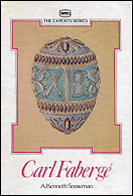
Video, 1982
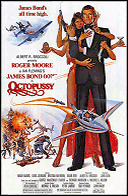
Movie, 1983
Notes: Narrations are in English and tapes are in VHS format, unless otherwise stated.
* Indicates no copy available in the McCanless Fabergé Library
Nicholas and Alexandra. Burbank (CA): Video distributed by RCA/Columbia Pictures Home Video, 1971.
The book by Robert K. Massie (New York: Atheneum, 1967) was made into a movie of the same name in 1971 in Great Britain. The plot is an intimate account of the reign of the last Romanov Tsar and the fall of Imperial Russia. Fabergé and his objects of vertu reflect this historic era. (Editor’s note: The film does not include Fabergé, but the book mentions Fabergé.)
Reviews of the movie:
Life, January 14, 1972, 14; Time, January 3, 1972, 66.
*Silberman, Syrl. Fabergé and the Masterpiece Theatre. Boston (MA): Television Station WGBH, 1978. Weekly television segments.
Fabergé objects mainly from The Forbes Magazine Collection and A La Vieille Russie were shown in weekly three-minute segments on the non-profit Public Broadcasting Service (PBS) television network beginning on Sunday, October 22, 1978, and continuing for 14 weeks. The Fabergé clips, narrated by TV personality Kitty Carlisle, followed the regular programming of the Masterpiece Theatre series, “The Duchess of Duke Street.”
Forbes, Timothy. Lost to the Revolution. New York: Forbes Magazine, 1981.
Video recording first shown on the non-profit Public Broadcasting System (PBS) television network on May 11, 1981, was written, produced and directed by filmmaker Timothy Forbes, son of Malcolm Forbes. The documentary film uses extensive original footage leading up to the catastrophe that befell the Russian Imperial Family. Fabergé Easter eggs from The Forbes Magazine Collection illustrate the historical details. Narrator: Actor Yul Brynner.
Weguelin, David. Carl Fabergé. London: WEG Video, Ltd., 1982.
Narrated by A. Kenneth Snowman, Fabergé expert and chairman of the British jewelry firm Wartski, the video discusses Fabergé’s life and background, and examines in detail more than 60 individual pieces in important private collections in Europe and America. Specific collections covered are The Forbes Magazine Collection, Josiane Woolf Collection, Wartski and objects from the Collection of Queen Elizabeth, the Queen Mother. The cover of the video box shows a previously unpublished watercolor signed by Fabergé of what was possibly intended to be an Imperial Easter Egg, but never delivered or perhaps never made.
Albert R. Broccoli for Eon Productions, released by Metro-Goldwyn-Mayer/United Artists. Octopussy. Santa Monica (CA), 1983. Movie, issued as a video in 2003.
In 1983 a film entitled Octopussy was made in Great Britain. The major part of the plot is a theft of state jewelry from the Kremlin Art Depository (fictional), replaced with forgeries, and the originals then smuggled into Western Europe to be sold.
A Fabergé egg modeled after the original Coronation Egg is found with a murdered British agent. It puts Agent 007 James Bond, played by Roger Moore, on the trail that leads to a devastating military plot to destroy détente and weaken NATO defenses in Europe. The movie is based on three short stories, Octopussy, The Living Daylights, and The Property of a Lady written by novelist/journalist Ian Fleming (1908-1965). On a world tour in 2002 the Bond egg was displayed at the London Science Museum and in 2002 at the Arizona Science Center in a venue entitled BOND. James Bond. The Exhibition. Additional information about the movie and short stories are in James Benson, The James Bond Bedside Companion. (New York: Dodd, Mead and Company, 1984.)
Fabergé-related background information: In 1963 Sotheby’s London commissioned a short story written by Ian Fleming, author of the 007 James Bond series, to be published in the Ivory Hammer: the Year at Sotheby’s [London: Longmans Green, 1963].
The story, Property of a Lady, was later published in Playboy and as part of James Bond short story collection entitled, Octopussy [various publishers: Jonathan Cape, 1966; New American Library, 1967; Triad/Panther Books, 1978].
A. Kenneth Snowman and his jewelry business Wartski are prominently featured in the short story – but not in the movie – about a fictional Fabergé auction at Sotheby’s. The objects sold at auction include the fictional Fabergé egg called the Terrestrial Globe.
Reviews of the movie:
The New Yorker, Vol. LIX, June 27, 1983, 93; Time, Vol. CXXI, June 27, 1893, 71; Magill’s Cinema Annual, 1984. Englewood Cliffs, NJ, 1984, 277-81.
*Christie’s Auction House. Silver Rhinoceros Automaton. New York, 1984.
The October 23, 1984, sale included a silver rhinoceros automaton with a sapphire horn which sold for $120,000, a new U.S. auction record. The video showing the rhinoceros walking forward and wagging his rear end was shown to the audience prior to the bidding.
The Art of Fabergé. Moscow: The Kremlin, 1989.
The Fabergé collection of the State Kremlin Collection is shown in its permanent installation in the Armoury Museum in Moscow. The charm of this video is the emphasis on showing the viewer the moving parts of the Fabergé eggs – on the Madonna Lily Clock egg the clock dial moves, and on the Trans-Siberian Railway Egg the train is removed from the egg and each section is featured in a close-up view. Later in the video a conservator takes a train car apart and the moving parts can be seen.
Similar details are shown for the Alexander Palace, Romanov Tercentenary and the Moscow Kremlin eggs. Video was first shown in Russia on LEN-TV, February 18, 1990.
*Byron McKinney Associates. Hillwood Museum: The Collection of Marjorie Merriweather Post. Washington (DC), 1989.
Dina Merrill (Editor’s note: née Nedenia Hutton), daughter of Marjorie Merriweather Post and E. F. Hutton, introduces her mother’s former home, Hillwood, in this video. Hillwood Museum has a collection of 18th and 19th century French and Russian decorative arts including over 90 Fabergé pieces. A selection of Fabergé is shown including the Twelve Monogram and Catherine the Great eggs.
Christie’s Auction House. Pine Cone Egg. Geneva, 1989.
Promotional video made for the May 10, 1989, auction of the Pine Cone Egg. The egg, made for Barbara Kelch, contains a 2” silver elephant automaton, which in this video is wound up and walks. The egg has been in a private American collection for 50 years and is one of five Fabergé eggs with an automaton. (Editor’s note: Sold to Joan Kroc, widow of Ray Kroc, McDonald’s fast food chain founder, for $3,140,000, and then shown at the joint U.S. and Soviet Fabergé exhibition later that year in San Diego).
Oy Ettan TV-Production. Carl Fabergé: Court Jeweler of the Tsars. Helsinki, Finland, 1989/90. Video in English with some subtitles for Finnish and Russian commentary.
Video hosted by Oleg Fabergé, grandson of Carl Fabergé, presents the story of Fabergé through interviews with Marina Lopato, Curator of the Foreign Silver and Gold Departments of the Hermitage Museum, Dr. V. [Vyacheslov] Muhin, former Director of Elagin Palace Museum, and Lydia Pihl, whose aunt Alma Pihl-Klee, designed the Winter and Mosaic Eggs. The filming was inspired by a Fabergé exhibition from the Fersman Mineralogical Collection at the Kalastajatorppa Hotel in Helsinki (Finland), June 20 – August 13, 1989. The exhibition was later shown at the Mineralogischen Staatssammlung in Munich (Germany), October 18, 1989 – January 14, 1990.
McClean, Peter. Living Dangerously – Malcolm Forbes: Grand Sportsman. (?): Thomas A. Horton Associates Video, 1991. Television series.
Shown on the Arts & Entertainment (A&E) Network, Living Dangerously, on January 30, 1991, featured the late Malcolm Forbes, Editor-in-Chief of Forbes Magazine. It chronicles the life of Forbes through his love of hot-air ballooning and motorcycling by using video footage from the Forbes archives.
The Forbes Friendship Tours, which took Forbes all over the world with his motorcycles and his hot-air balloons built to reflect the culture of the host country promoted Forbes Magazine. This video segment included Fabergé objects, toy soldiers, the French castle, Chateau de Balleroy, and the Rosebud Egg hot-air balloon, and three of his sons, Timothy, Robert, and his eldest son Steve (Malcolm S., Jr.).
Dörr, Ulricke et al. Carl Fabergé: The Man with the Golden Hands. Cologne, Germany: Deutsche Welle TV, 1992. Video in German, later edition in English. Also published as part of the series, Images of Germany.
Documentary on the life and art of Carl Fabergé featuring The Forbes Magazine Collection in New York is combined with historical footage and inside views of the Hermitage Museum in St. Petersburg. Dr. Géza von Habsburg, Christopher “Kip” Forbes, and Paul Schaffer of the New York firm A La Vieille Russie are interviewed. Video concludes with two companies who are continuing the tradition in the style of Fabergé – Victor Mayer in Pforzheim, Germany, with an interview by Dr. Herbert Mohr-Mayer, and in St. Petersburg by Andrei A. Ananov. (Editor’s note: Photo of Alexander III is actually a photo of Alexander II. In the Mayer section the video erroneously states the original House of Fabergé did not employ a variety of craftsmen in the making of each egg.)
Reviews:
School Library Journal, Vol. 46, No. 5, May 2000, 70-71; Booklist (student edition), Vol. 96, No. 21, July 2000, 2049; Library Journal, Vol. 125, No. 15, September 15, 2000, 127.
State Museums Moscow Kremlin. Fabergé Easter Eggs. Moscow: Kremlin and COMINFO, 1992. Interactive Computer Diskette.
A Floppy Book entitled Moscow Kremlin is an interactive disk on the Fabergé Easter Eggs owned by the Armory Museum inside the Kremlin. The photos stem from the 1992 Mir Fabergé (World of Fabergé) catalog accompanying the Zvonitsa Exhibition Hall venue in the Kremlin (Editor’s note: September 15, 1992 – January 15, 1993) to commemorate the 150th anniversary of the founding of the Fabergé firm. The story of each egg is supplemented with a biographical sketch of Fabergé and a timeline.
CBS (Columbia Broadcasting System)/Universal Studies Home Video. Murder, She Wrote – An Egg to Die For. New York, 1994. Television series.
An episode of the long-running American television series, Murder, She Wrote, starring Angela Lansbury as detective Jessica Fletcher, solves a Fabergé egg mystery. At a book fair in Miami Beach she helps a Russian police officer capture the elusive mastermind behind the theft of a golden egg stolen from the Hermitage Museum. First shown on December 11, 1994.
Christie’s Auction House. Winter Egg. Geneva, 1994.
Promotional video made for the November 16, 1994, auction of the Winter Egg. These are the first pictures of the egg since 1949 when the egg was last seen. The estimate is $2,500,000 – 4,000,000. (Editor’s note: A world record of $5,587,308 was realized; eight years later in 2002 the same egg sold for $9,579,500 at auction.)
Staatliches Museum des Moskauer Kreml. Die Weltberühmten Fabergé-Ostereier. COMINFO and Markt & Technik Interactive, 1995-1997. Interactive CD in German, later edition in Russian with the title, Paskhal’nye laitsa Faberzhe.
Fabergé eggs are featured in 200 photos with text and 24 videos in a 50-minute long interactive presentation with a 30-minute narration including –
- Eggs owned by the Armoury Museum of the Kremlin, and other collections such as The Forbes Magazine Collection
- History of the Fabergé firm with a time line
- Egg gallery in which selected eggs are unpacked and assembled for an exhibition (Editor’s note: Possibly the January 30 – March 15, 1990, Zvonitsa Exhibition Hall venue in Moscow where 25 Fabergé were displayed after the highly successful first-time joint American-Russian exhibition had closed in San Diego, California, October 22, 1989 – January 7, 1990), and an
- Interactive quiz.
Many interesting views of the eggs are shown, particularly note-worthy are the Clover Leaf Egg, which due to its fragile nature does not travel, and the individual parts of the Madonna Lily Clock Egg as well as the train cars of the Trans-Siberian Railway Egg. Irina Polynina, the Head of the Diamond Fund of the Kremlin, and Margaret Kelly Trombly, Director of The Forbes Magazine Collection, are shown.
Reviews: Osteuropa: Zeitschrift für Gegenwartsfragen des Ostens, Vol. 50, no. 3, March 22, 2000, 334-5.
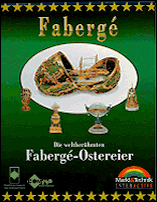
Interactive CD, 1995-97
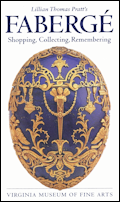
Video, 1996
ABC (American Broadcasting Company) Network. Good Morning America. New York, 1996.
During a television program entitled, Good Morning America, Joan Rivers, a Fabergé collector, Dina Merrill, whose mother Marjorie Merriweather Post collected Fabergé, and Dr. Géza von Habsburg, a Fabergé expert, are interviewed. They share reminiscences for an introduction to the Fabergé in America exhibition, which opened at the Metropolitan Museum in New York City in February 1996, and traveled to four other cities, Richmond (VA), San Francisco, New Orleans (LA), and Cleveland (OH).
Arvo Tuominen for the Finnish Broadcasting Company. Fabergé and Finland (Fabergé ja Suomi). Helsinki, 1996. Video, predominantly in English, with subtitles for Finnish and Russian narratives.
This scholarly video was produced in celebration of the 150th anniversary of the birth of Peter Carl Fabergé and the Washington (DC) exhibition, Fabergé and Finland, at the Corcoran Gallery. Shown on Finnish television December 25, 1996, and at Easter 1997, it includes film footage of the traveling Fabergé in America venue in San Francisco. (Editor’s note: Corcoran dates are October 17, 1996 – January 5, 1997; San Francisco: May 25 – July 28, 1996.)
Telling the story of Fabergé are:
- Author Dr. Ulla Tillander-Godenhielm
- Dealers Peter Schaffer of A La Vieille Russie and Alexis de Tiesenhausen of Christie’s auction house
- Collectors Christopher “Kip” Forbes of The Forbes Magazine Collection, cigarette case collector John Traina, and Finnish collectors Matti Koskimies and Arvo Paloheimo
- Curators Dr. Marina Lopato of the Hermitage Museum and Lyudmila Bakayutova of the Fabergé Arts Foundation, St. Petersburg, and
- Family members Anni Sarvi, granddaughter of Henrik Wigström; Beatrice Fabergé-Strandman and Frances Fabergé, great granddaughters of Peter Carl Fabergé.
Other highlights are:
- Film footage of the Christie’s Geneva 1994 Winter egg auction
- Guided tour of the original Fabergé premises of Bolshaia Morskaia 24 in St. Petersburg by Dr. Tillander-Godenhielm
- Look at the home town and cottage in Finland of Fabergé workmaster Henrik Wigström after the Russian Revolution, and the
- Story of Alma Pihl, Fabergé designer.
Grayson Family Productions in cooperation with the Mississippi Commission for International Cultural Exchange. The Palaces of St. Petersburg: An Imperial Adventure. Jackson (MS), 1996.
Television feature reporter Walt Grayson takes the viewer on a journey to St. Petersburg, Russia, where he visits the actual Russian palaces. Historical footage showing the destruction of the palaces during World War II is juxtaposed with the palaces open to tourists in the mid-90’s in Russia. Included are the Peterhof, Gatchina, Pavlosk palaces, and the Catherine Block of the State Museum at Tsarkoe Selo.
For the Jackson, Mississippi, venue five rooms were recreated with objects on loan from the Russian palaces as well as replacement objects made for those destroyed in Russia during the World War II. After the exhibition the replacements were sent to permanent locations in each of the Russian palace museums.
The final part of the video is a detailed, narrated tour of the five rooms as seen in the Jackson exhibition with a select group of Fabergé objects. (Editor’s note: Title on the video box is St. Petersburg and the Palaces.)
Morais, Lee. Fabergé: Jeweler to the Tsar. New Orleans (LA): New Orleans Museum of Art, 1996. Video and audio guide.
An introductory video to the Fabergé in America venue at the New Orleans (LA) Museum of Art and an accompanying Acoustiguide entitled Fabergé in America explain the exhibition, which also traveled to New York, Richmond (VA), San Francisco, and Cleveland (OH).
Robb Weller and Gary H. Grossman Productions for Arts & Entertainment Television Networks. Fabergé: Imperial Jeweler. New York, 1996. Video, also later issued with a new title, Fabulous World of Fabergé.
The New York Metropolitan Museum opening of the traveling Fabergé in America exhibition introduces this overview of the story about the Russian court jeweler, Peter Carl Fabergé (1846-1920). Historical footage combined with explanations by historian Peter Kurth and curator Dr. Géza von Habsburg (erroneously cited as Hapsburg), collectors Joan Rivers and John Traina, Margaret Kelly (Trombly) for The Forbes Magazine Collection, dealers Kenneth Snowman of Wartski’s in London, and Peter Schaffer of A La Vieille Russie in New York, and great granddaughter, Tatiana Fabergé, complete the narration. Photographs of all four sons of Fabergé and his wife Augusta illustrate the family story during the reign of Tsars Alexander III (1845-1893) and Nicholas II (1868-1918). (Editorial note: Photograph of Agathon Fabergé in the video is the son of Carl Fabergé, while the script discusses Agathon Fabergé, the brother of Carl.)
The name of Fabergé was sold in the 1950’s. The traditions of the House of Fabergé are carried on today by the firm of Victor Mayer in Pforzheim, Germany, led by Dr. Herbert Mohr-Mayer, and also a grandson, Theo Fabergé, in England. The modern-style English eggs made by Mr. Fabergé use wood and lead crystal, materials not used by his famous grandfather.
TvW 7 in Association with the Bromley Management Group. Secret Treasures of the Kremlin. Australia, 1996. Video published in 1998 by Zia Home Entertainment.
This video shot by an Australian television crew commemorates the 150th anniversary of the birth of Peter Carl Fabergé, and the traveling Fabergé exhibition, World of Fabergé, to Perth, Melbourne, and Sydney, Australia. The contract for this exhibition took two years to negotiate even after the end of the cold war. Many of the scenes of Russian life in the video were once forbidden to foreign film crews.
Irina Polynina, the Head of the Diamond Fund of the Kremlin, and Irina Rodimtseva, Director of the Armoury Museum, are featured prominently. Of particular interest to Fabergé enthusiasts are the ringing of the chimes of the Moscow Kremlin Egg and the close-up view of the train in the Trans-Siberian Railway Egg.
Virginia Museum of Fine Arts. Lillian Thomas Pratt’s Fabergé: Shopping, Collecting, Remembering. Richmond, 1996.
Five of the Fabergé eggs in Mrs. Pratt’s collection are shown in stunning close-ups revealing the surprises and other inside details. These views are usually reserved for museum curators and conservators. (Richmond Times-Dispatch, February 24, 1995, B8)
The video, based on a script written by curator Dr. David Park Curry, includes 1896 newsreel footage about Nicholas II and Alexandra in Russia, an interview with Mrs. Pratt Ashton, a niece of Mr. Pratt, and many other details about the life and times of Mr. and Mrs. John L. Pratt, who lived in Chatham Manor, Fredericksburg (VA).
Mrs. Pratt (1876?-1947) acquired her Fabergé collection between 1933-1945. Upon her death it was willed to the Virginia Museum and her husband, a General Motors executive, funded the first installation of this collection as a memorial to his wife.
Dr. Curry states in the video that Fabergé scholarship has come far since the 1930-40’s, because it is now known some of the flowers in this collection are not original pieces of Fabergé. A companion book, Fabergé, published by the Virginia Museum of Fine Arts was part of the 1996 traveling exhibition, Fabergé in America.
Christie’s New York. Pine Cone Egg Auction. New York, 1997. In English with some Russian.
Promotional video includes unique views of the automaton elephant surprise topped by a seated mahout as it walks. A brief history of the Kelch family and their eggs is included. The Pine Cone Egg was on view in New York before the auction in April 1997. (Editor’s note: The pre-sale estimate for the egg owned by Joan Kroc of San Diego, California, was $3,500,000 – $4,000,000. The egg was passed in at $2,800,000).
A brief mention is also made of the April 15, 1997, auction of more than 160 Fabergé objects owned by William Kazan, Lebanese diplomat and collector. Anthony Phillips and Alexis de Tiesenhausen of Christie’s are interviewed as well as Valentin Skurlov, Russian Fabergé researcher.
Dateline produced by NBC (National Broadcasting Corporation). The Last Tsar. New York, 1998.
Dateline, a weekly NBC television news program on July 19, 1998, included a segment commemorating the 80th anniversary of the execution of Tsar Nicholas and his family in Ekaterinburg, Russia. On the anniversary date the Tsar, his wife Alexandra Fedorovna, and three of their children were buried in the Peter and Paul Cathedral in St. Petersburg, Russia. Author Robert Massie (Nicholas and Alexandra, 1967, video in 1971) and Jim Broughton, organizer of the Nicholas and Alexandra: The Last Imperial Family of Tsarist Russia venue (August 1, 1998 – February 14, 1999) in Wilmington (DE) are interviewed.
Romanov Treasures as part of a series entitled, A Wonder of the World. New York: Intervista for NHK Japanese Public Television, 1998. In Japanese.
Filming took place in all the major Fabergé collections of the world. The Swan and Peacock eggs are shown with moving parts.
Greystone Communications for Arts & Entertainment Home Video. Treasure! The Czar’s Fabergé Eggs. New York, 1998.
The story of the Fabergé eggs is discussed by Margaret Kelly Trombly and Christopher “Kip” Forbes of The Forbes Magazine Collection, Robert Massie, author of the book, Nicholas and Alexandra, collector John Traina, Fabergé expert Dr. Géza von Habsburg, and Anne Odom, chief curator, Hillwood Museum and Gardens. This home video was published as part of the Arts & Entertainment series, Treasure!
Karl Fabergé, Jeweler of the Russian Empire. St. Petersburg: The Hermitage Museum, 1999. Video in Russian.
Dr. Mikhail Piotrovsky, Director of the Hermitage Museum in St. Petersburg, introduces this video about Peter Carl Fabergé and other contemporary St. Petersburg jewelers around the turn of the 20th century. The varieties of Fabergé objects featured are from the Hermitage Museum Collection and a select group of eggs from other worldwide collections. The script was written by Fabergé expert and author, Dr. Marina Lopato.
Public Broadcasting Corporation with Stoner Productions, Inc. Treasures of the World. Alexandria (VA): PBS Video, 1999.
Three volumes in this series cover masterworks of art, which inspired not only devotion and discovery but also mishaps, madness and intrigues. Volume 2 including a section entitled, Fabergé Eggs: Mementos of a Doomed Dynasty, combines historical footage of the coronation of Tsar Nicholas II and several close-up views of the coronation coach and other Fabergé eggs. Authors Lynette Proler, Dr. Géza von Habsburg and Christopher “Kip” Forbes are interviewed. Lesson plans for middle and high school students accompany this video – the students are asked, “What do the things we treasure tell us about ourselves and the culture in which we live?”
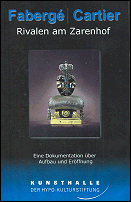
Munich, 2003
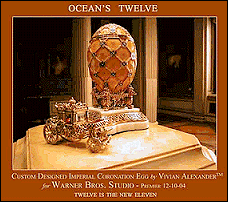
Movie, 2004
Noey, Christopher. A Visit to Hillwood Museum and Gardens. Washington (DC): Hillwood, 2000.
A short video serves as an introduction to the 25-acre landscaped estate of Marjorie Merriweather Post (1887-1973). An avid collector of Imperial Russian fine and decorative arts Mrs. Post is introduced by her daughter Dina Merrill, her granddaughter, Ellen Charles, and Anne Odom, chief curator. The Icon Room in the museum contains two eggs and other objects by Fabergé. Hillwood was bought by Mrs. Post as her home in 1955 and after her death became a museum located in the northwest Washington (DC).
Arts & Entertainment Television Network. Modern Marvels: Million Dollar Tech. New York, 2000/2001.
A minor segment showing a mixture of original and modern-style Fabergé eggs is included in this History Channel video. The difference between the eggs is not stated.
HGTV (Home and Garden Television). Collectible Treasures. Knoxville (TN), 2001.
Fabergé collector John Traina shows some of his collection of over 500 Fabergé cigarette cases. As a smoker some 20 years ago, Mr. Traina began collecting and now, as a non-smoker, shares his delight for the variety of cases made from different materials and many hues. He is particularly found of those with provenances gained through existing inscriptions, for example: “January 18, 1942. Merci” given by Barbara Hutton to her husband Cary Grant; a present to the King of Sweden with the inscription “Nicki and Alix, 15 VI 1907” (Nicholas II and Alexandra); a Fabergé cigarette case loaned for a cameo appearance in the Woody Allen movie, Small Time Crooks, is insured for $500,000 (Editor’s note: Other sources erroneously state the case was insured for $1 million, it is the cover illustration of Mr. Traina’s book, The Fabergé Case: From the Private Collection of John Traina [New York: Abrams, 1998]).
The Royals & Their Pets. London: Imagicians Television, 2003.
On December 22, 2004, The Royals & Their Pets, premiered on British television and included the pets of Queen Alexandra and King Edward VII. Geoffrey Munn, Managing Director of Wartski and contributor to The Antiques Roadshow, enhances royal pet lore by sharing the story of Caesar, King Edward’s Norfolk terrier, and shows a collection of Fabergé hardstone animals.
The Fabergé Caesar wears a collar with the inscription, I Belong to the King. The white cockatoo by Fabergé shown in the video is especially charming in that it appears ready to take flight from a golden perch. Fabergé sent modelers from Russia to Sandringham to make wax models of the royal animals and today Fabergé enthusiasts can see hardstone animals in the British Royal Collection and at Warski on Grafton Street, London.
Manfred Ahrens with the Kunsthalle der Hypo-Kulturstiftung. Fabergé/Cartier – Rivalen am Zarenhof. Munich: Kunsthalle, 2003. Video, multi-lingual, predominantly in German.
Seventeen years ago in 1986-87 two cousins, Dr. Géza von Habsburg and Dr. Johann Georg Prinz von Hohenzollern, assembled the first Fabergé exhibition in Munich. The show had 250,000 visitors. In this video for the 2003-04 exhibition they worked together again to show how the Russian jeweler Fabergé and his French contemporary Cartier competed in St. Petersburg. The first part of the videotape is a behind-the-scenes look during a 17-day countdown before opening day, and is followed by a review of the finished exhibition and then concludes with scenes from of the opening events.
The missing 1917 Karelian Birch Egg, recently found complete with documentation, is unveiled for this exhibition and is shown with a look inside. The 1,000 objects borrowed include pictures, paintings, Fabergé and Cartier objects, and a wide range of clothing worn by members of the Romanov family.
(Editor’s note: On May 4, 2004, Dr. Géza von Habsburg gave a lecture on this same topic at the Indianapolis Museum of Art in connection with an exhibition entitled, Gifts to the Tsars, 1500-1700. A video entitled, Cartier & Fabergé: Rivals to the Tsars, was made.)
Warner Brothers. Ocean’s Twelve. Hollywood (CA), 2004. DVD.
The plot of the movie revolves around the feud between Ocean and Terry Benedict and is a follow-up to a 2001 movie entitled Ocean’s 11 with the same cast including among others, George Clooney, Julia Roberts, Brad Pitt, Matt Damon. A heist in Rome includes a modern-style Fabergé Coronation Egg made by the firm of Vivian Alexander, Maurice (LA). An egg from the numbered series was shown at the Gadsden (AL) Cultural Arts Center in November 2004.
Bernd Boehm in Association with ARTE. Fabergé: Ostereier für die Zaren. Berlin, Germany: Boehm-Lutz Filmproduktion, 2009. DVD.
Produced for German and French television audiences the story of Fabergé is told by an actor portraying Karl Fabergé. A majority of the 50 known Fabergé Easter eggs scattered in museums and private collections are shown as the story of Nicholas and Alexandra unfolds. Two fictional eggs shown in the scenes from the movies, Octopussy (2003) and Ocean’s Twelve (2004), are appended at the end along with footage for The Forbes Magazine Collection sale and the auction of the 1902 Rothschild Egg.
Mark Stewart Productions. Fabergé: A Life of its Own. London, UK. 2017. Blu-ray | DVD | iTunes.
The award-winning documentary film includes stunning new images of the world’s most valuable Easter egg: Fabergé’s “Winter Egg” of 1913.
Looking for more audio-visual materials? Visit Miek’s Fabergé Eggs.
